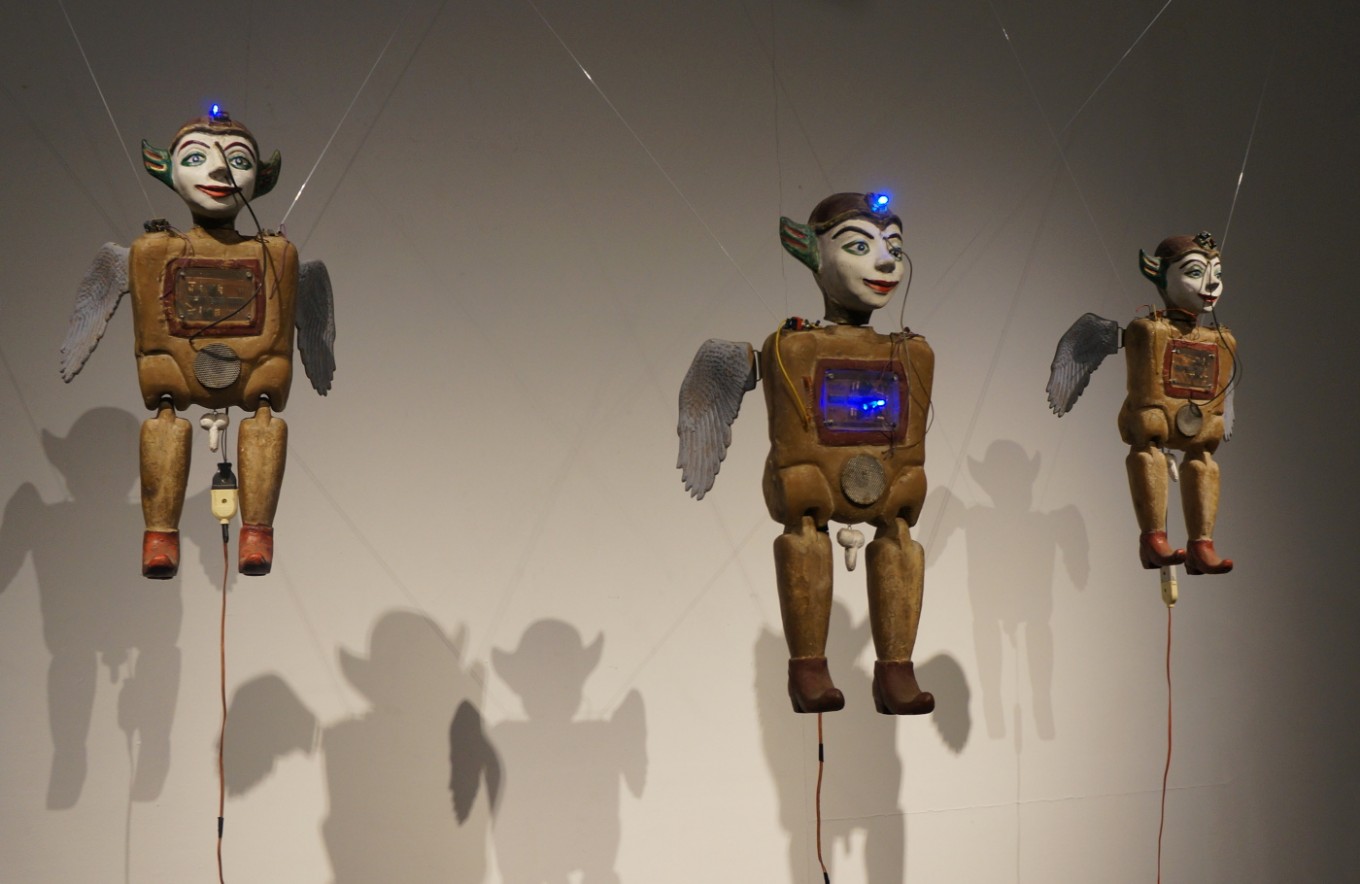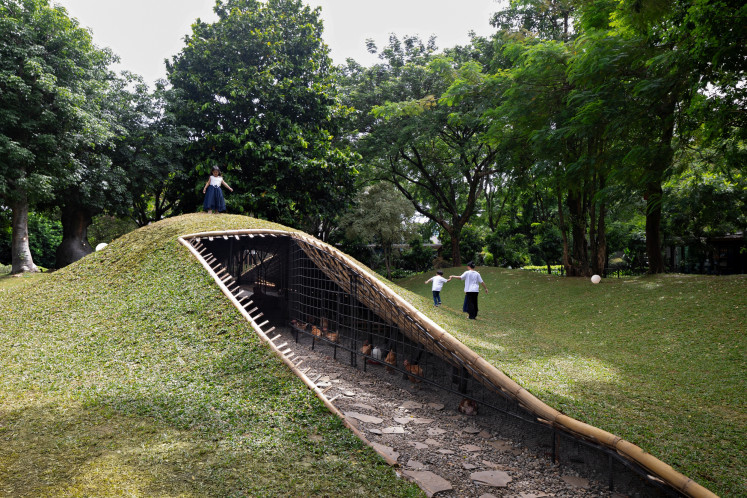Popular Reads
Top Results
Can't find what you're looking for?
View all search resultsPopular Reads
Top Results
Can't find what you're looking for?
View all search resultsEngage the senses at media installation art exhibition
Change text size
Gift Premium Articles
to Anyone
N
ine artists from Korea and Indonesia are showcasing their distinctive artworks at the latest Korea-Indonesia Media Installation Art Exhibition with "Dialogue with the Senses" as this year’s theme. Held until Nov. 3 at Galeria Fatahillah, Jakarta, this free-admission exhibition enables visitors to use five of the senses.
Symphonie Aquatique (2016) by Korean electronic music composer Park Seung-soon is one of the works on display. In the blue area that resembles an underwater setting, several glass bowls containing water have been mapped with various traditional Indonesian musical instruments' sound patterns using sensors.
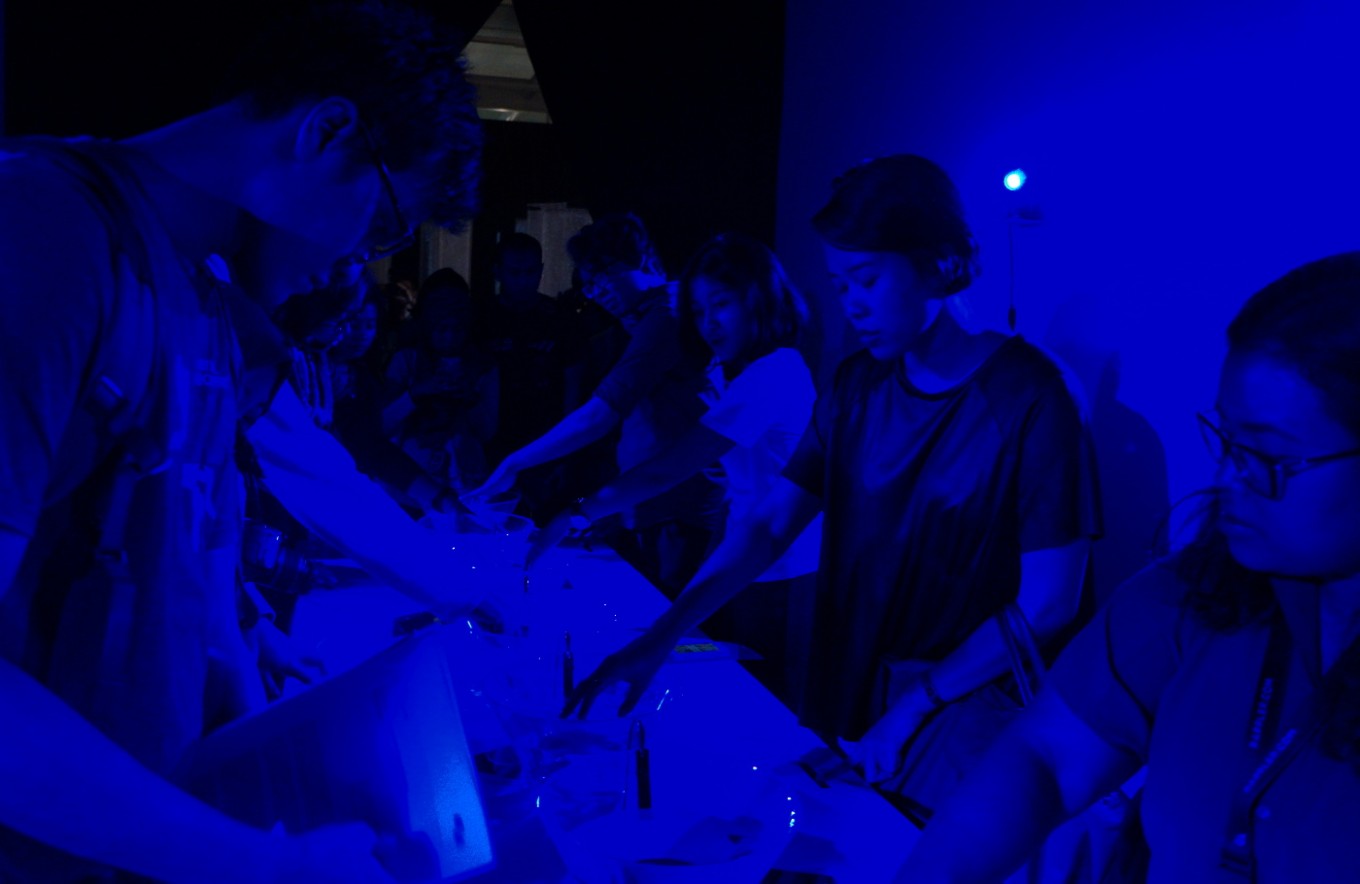 Visitors marvel at Symphonie Aquatique (2016) by Park Seung-soon.(JP/Ni Nyoman Wira)
Visitors marvel at Symphonie Aquatique (2016) by Park Seung-soon.(JP/Ni Nyoman Wira)
“My artworks require involvement by visitors,” Seung-soon said. Visitors can touch a piece of tape near the bowl with one hand and water with the other to "listen" to the music. “The more people [who touch the water], the merrier,” he said. There is also the sound of the gamelan, seruling (flute) and other traditional music instruments.
“Since the beginning, my focus has been on music,” Seung-soon told The Jakarta Post. “Besides making music, I thought of ways to combine it with nature. My first option was water. Based on my research, water is suitable to be merged with the music movement.”
 "Rasarumah" home aromatherapy (2016) by Fajar Abadi indulges the sense of smell with the aroma of chicken soup and "doenjang jjigae".(JP/Ni Nyoman Wira)
"Rasarumah" home aromatherapy (2016) by Fajar Abadi indulges the sense of smell with the aroma of chicken soup and "doenjang jjigae".(JP/Ni Nyoman Wira)
Meanwhile, indulging the sense of smell, Bandung-based artist Fajar Abadi presents "Rasarumah" home aromatherapy (2016). Placed above a plastic board, his artwork consists of two bowls. The first is a bowl with a hand-painted chicken motif (mangkuk ayam), commonly used by Indonesian street food vendors, containing an essential oil of sup ayam (chicken soup). The second is a ddukbaegi (earthenware bowl) containing an essential oil of Korean dish doenjang jjigae (fermented soybean paste stew). Aside from the appearance, the placement of the bowls also resembles the different cuisines of the two cultures.
 Exhibition curator Jeong-ok Jeon (left) tries to taste the sugar "diamond" in "Sucker Zucker" (2016) by Elia Nurvista.(JP/Ni Nyoman Wira)
Exhibition curator Jeong-ok Jeon (left) tries to taste the sugar "diamond" in "Sucker Zucker" (2016) by Elia Nurvista.(JP/Ni Nyoman Wira)
“I find that smell affects certain parts of our brain that trigger what appears to be random, forgotten or fond feelings,” Fajar said. The process started when he made infused oils from several ingredients, including chicken, pepper and onions. Later he combined them to create the essential oils.
The process took eight to 10 hours with a high chance of failure. Fajar chose chicken soup because it was one of his first meals after weaning (sapih) when he was little, while doenja jjigae was often served at the time of his residency in Korea.
“Usually aromatherapy smells unique like lavender, but this one smells like the kitchen. I want people to be hungry and feel nostalgic for their home.” Fajar added that he wanted to create rendang and sambal essential oils in the future using distillation to create even stronger aromas.
(Read also: New art exhibition opens at National Gallery)
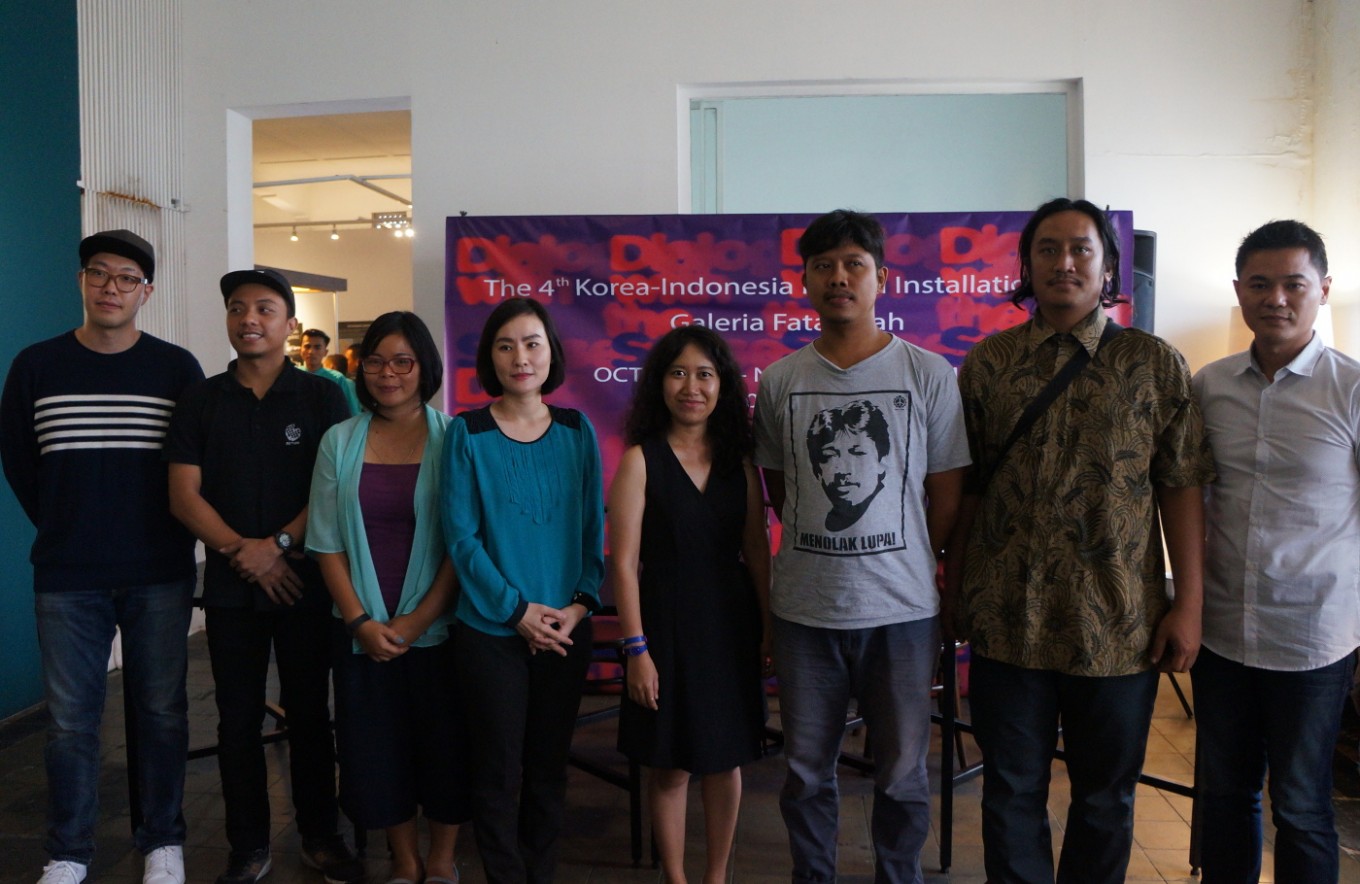 Korean and Indonesian artists pose for a photo with exhibition curator Jeong-ok Jeon.(JP/Ni Nyoman Wira)
Korean and Indonesian artists pose for a photo with exhibition curator Jeong-ok Jeon.(JP/Ni Nyoman Wira)
Notable artworks that are on display consist of The Trio Angels (2016) by Heri Dono, which was is inspired by movies Charlie’s Angels; Jangdna (2015) by Kim Hyung-joong that shows the connection between musical rhythm with the human voice with a concept of DNA; and Obsession/Love Forever (2007) by Lee Hye-rim, which questions the role of new technologies in image making and representation as part of her ongoing artwork series TOKI/Cyborg Project since 2003.
Other artworks displayed include Games of the New Emerging Forces by Anang Saptoto, which plays with angle and the spatial element to create a 3D illusion; Interactive SeeSea Drawing (2016) by Choi Suk-young, which enables visitors to see their drawings come alive and swim in the ocean through art; Illogical Room (2016) by Ricky “Babay” Janitra, which shows that there is something missing amid life with the internet where the visitors are allowed to walk through the installation; and Sucker Zucker or sugar exploitation (2016) by Elia Nurvista, consisting of lick-able sugar "diamonds" and in which visitors can take home sugar "candy" by just paying Rp 75,000 ($5).
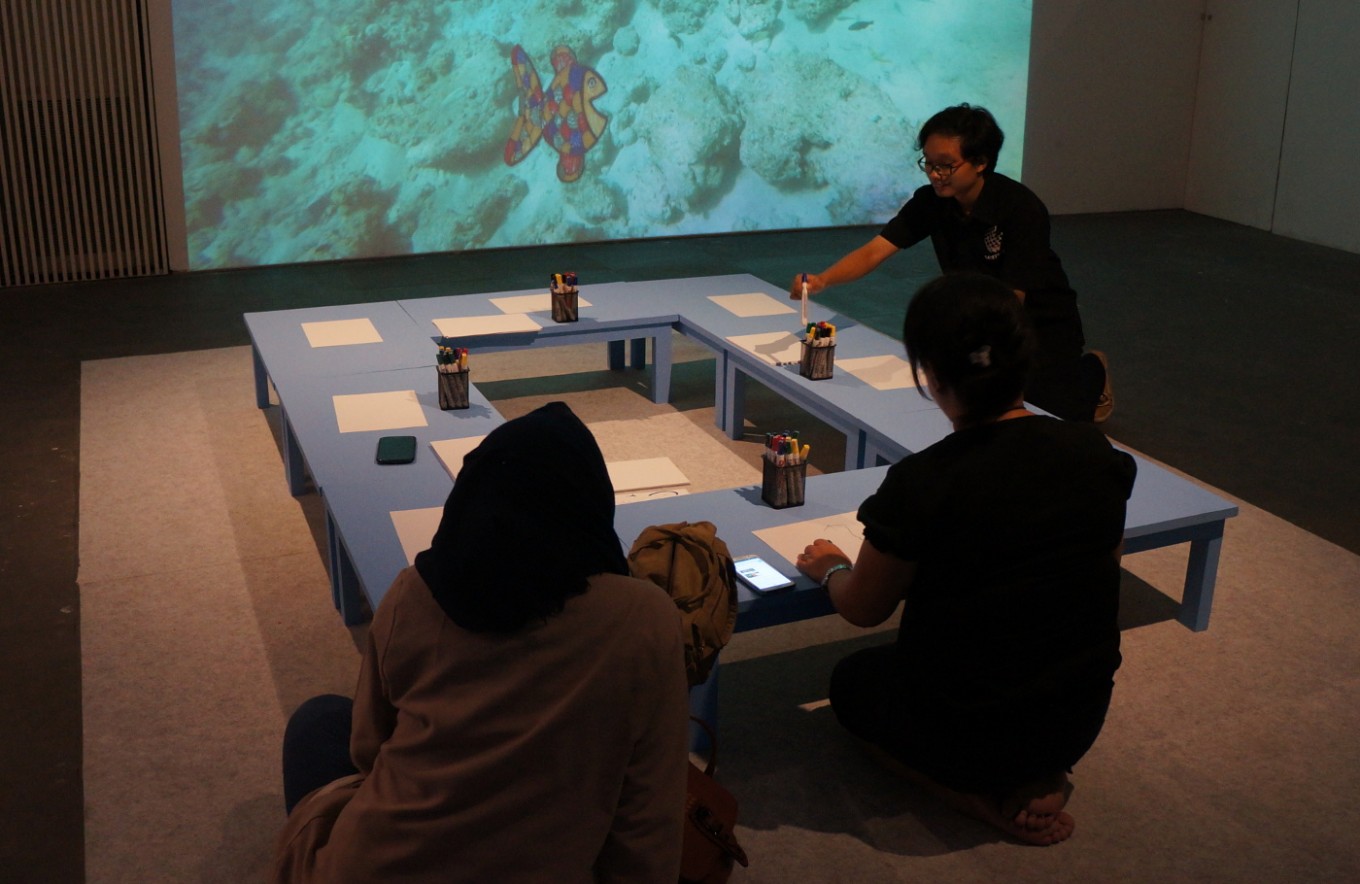 Visitors see their drawings come alive on the screen in "Interactive SeeSea Drawing" (2016) by Choi Suk-young.(JP/Ni Nyoman Wira)
Visitors see their drawings come alive on the screen in "Interactive SeeSea Drawing" (2016) by Choi Suk-young.(JP/Ni Nyoman Wira)
Korea-Indonesia Media Installation Art Exhibition was first held in 2013 to commemorate diplomatic relations between the two countries. It has always featured the latest contemporary works by young, talented artists.
“Whenever we go to other exhibitions, we just use one sense, which is sight,” said this year’s exhibition curator Jeong-ok Jeon. “Instead of using all of our bodily senses, we are only allowed to use one sense just by looking at the painting, sculpture. This creates a sort of barrier.” She said the artworks in this media installation art exhibition would be incomplete without visitor participation. Thus, the selected artworks invite visitors to get involved.
Besides the exhibition, there is a gallery tour, an early art workshop by rurukids and a teenager art workshop by Serrum And Plus. (asw)

